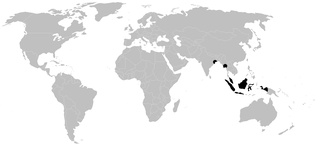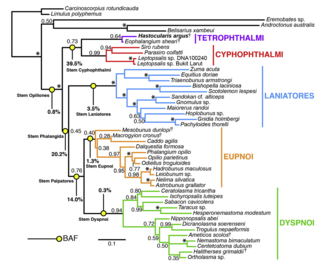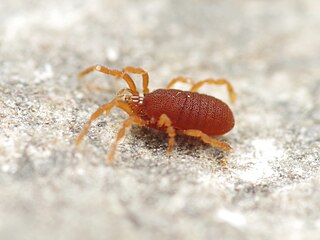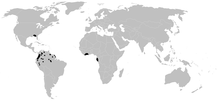
The Opiliones are an order of arachnids colloquially known as harvestmen, harvesters, harvest spiders, or daddy longlegs. As of April 2017, over 6,650 species of harvestmen have been discovered worldwide, although the total number of extant species may exceed 10,000. The order Opiliones includes five suborders: Cyphophthalmi, Eupnoi, Dyspnoi, Laniatores, and Tetrophthalmi, which were named in 2014.

Cyphophthalmi is a suborder of harvestmen, colloquially known as mite harvestmen. Cyphophthalmi comprises 36 genera, and more than two hundred described species. The six families are currently grouped into three infraorders: the Boreophthalmi, Scopulophthalmi, and Sternophthalmi.

The Sironidae are a family of harvestmen with more than 60 described species.

Troglosironidae is a family of harvestmen with seventeen described species in a single genus, Troglosiro, which is found on the island of New Caledonia, in the Pacific Ocean.

Ogoveidae is a family of harvestmen with three described species in one genus, Ogovea, which is found in equatorial West Africa.

The Stylocellidae are a family of harvestmen with about 40 described species, all of which occur in Southern or Southeastern Asia. Members of this family are from one to seven millimeters long. While Stylocellus species have eyes, these are absent in the other two genera.

The Cranaidae are a family of neotropical harvestmen within the suborder Laniatores.
The Zalmoxidae are a family of harvestmen within the suborder Laniatores.

Harvestmen (Opiliones) are an order of arachnids often confused with spiders, though the two orders are not closely related. Research on harvestman phylogeny is in a state of flux. While some families are clearly monophyletic, that is share a common ancestor, others are not, and the relationships between families are often not well understood.
Gonzalo Giribet is a Spanish-American invertebrate zoologist and Alexander Agassiz Professor of zoology working on systematics and biogeography at the Museum of Comparative Zoology in Harvard University. He is a past president of the International Society for Invertebrate Morphology, of the Willi Hennig Society, and vice-president of the Sociedad Española de Malacología.
Huitaca boyacaensis is a species of neotropical harvestmen in the family Neogoveidae, first described by Ligia Benavides and Gonzalo Giribet in 2013.
Canga renatae is a species in a monotypic genus of harvestmen in the family Neogoveidae. It was discovered in 2010 in a cave system in the Serra dos Carajás, Pará State, Brazil.

Neosiro exilis is a species of mite harvestman in the family Sironidae. It is found in North America.

Metasiro sassafrasensis is a species of mite harvestman in the family Neogoveidae. It is found in North America.
Parasironidae is a family of harvestmen with 7 described species.

Ebrosiro is a genus of harvestmen belonging to the family Parasironidae, it is monotypic with one described species. It is found in Southern Europe.
Cimmerosiro is a genus of harvestmen in the suborder Cyphophthalmi with three described species. All three species are found in Eastern Europe and West Asia.
Tirrenosiro is a genus of harvestmen in the suborder Cyphophthalmi with two described species. Both species are found in Southern Europe.
Triaenonychoidea is a superfamily of armoured harvestmen in the order Opiliones. There are 4 families and more than 440 described species in Triaenonychoidea.











